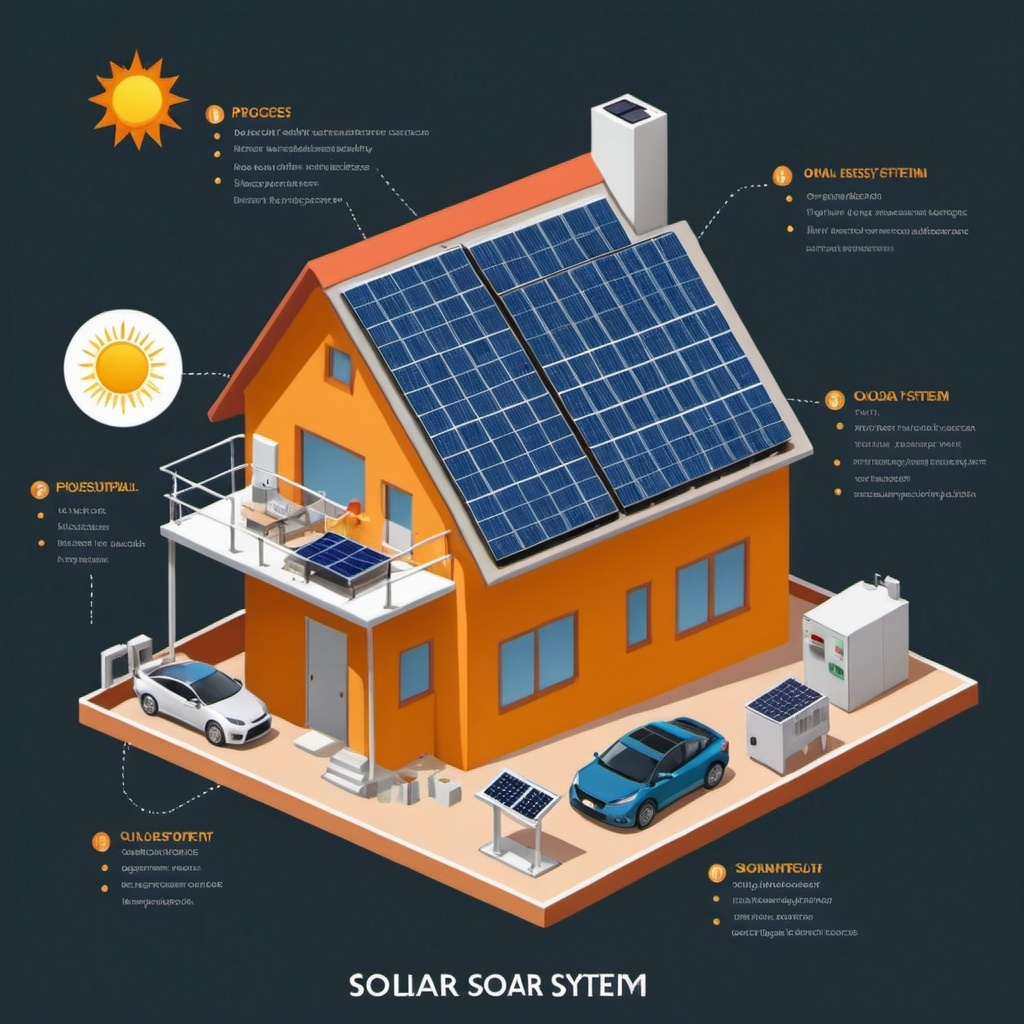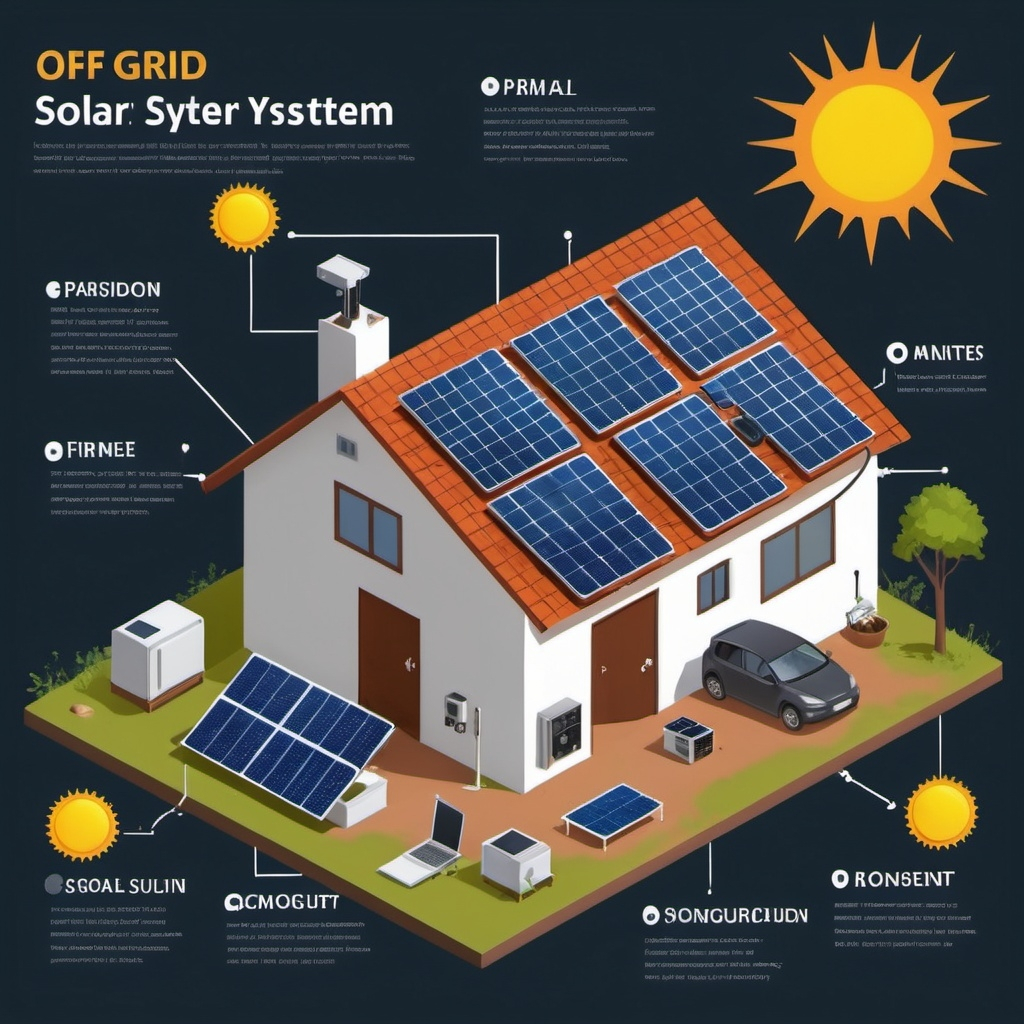Solar Solutions
- Home
- Solar Solutions

ON-GRID SOLAR SYSTEM
An On-Grid Solar System, also known as a grid-tied or grid-connected solar system, is designed to work in conjunction with the utility grid. This system has several advantages and operates in a way that optimizes energy use and cost savings for the homeowner.
Daytime Operation
During the daytime, solar panels generate electricity from sunlight. The generated electricity can be used to meet the energy needs of the home, such as powering appliances, lighting, and other electrical devices. If the generated electricity exceeds the home’s consumption, the surplus electricity is sent to the utility grid. This is facilitated by a special device called a Net Meter.
Net Meter
A Net Meter plays a crucial role in an On-Grid Solar System. It records the amount of electricity the home consumes from the grid and the excess electricity sent back to the grid. The net meter keeps a precise account of incoming and outgoing electricity, allowing homeowners to track their energy usage and generation. This balance is crucial for understanding the energy flow and for billing purposes.
Nighttime Operation
At night, when the solar panels are not generating electricity, the energy needs of the home are met by drawing electricity from the utility grid. This ensures a continuous power supply without the need for expensive battery storage solutions.
Financial Benefits
One of the significant benefits of an On-Grid Solar System is the potential for substantial savings on electricity bills. By generating their own electricity during the day, homeowners reduce their reliance on the grid, which lowers their energy costs. Additionally, if the system generates more electricity than the home consumes, the excess electricity sent to the grid can earn credits or even monetary compensation, depending on the utility company’s policies and local regulations.
In summary, an On-Grid Solar System is an efficient and cost-effective way to harness solar energy. It provides a reliable power supply by utilizing the grid as a backup, reduces electricity bills, and can generate additional income from surplus energy production. This type of system is particularly advantageous for homes with high daytime energy usage and those looking to minimize their environmental footprint while enjoying economic benefits.
OFF-GRID SOLAR SYSTEM
An Off-Grid Solar System, also known as a standalone solar system, operates independently of the utility grid. This type of system is ideal for remote locations, areas with frequent power outages, or for those who prefer complete energy independence. Here’s how an Off-Grid Solar System functions and its key benefits.
Daytime Operation
During the daytime, solar panels generate electricity from sunlight. This electricity is used to meet the immediate energy needs of the home, such as powering appliances, lighting, and other electrical devices. In addition to direct consumption, the generated electricity is also used to charge a battery bank. The battery bank stores excess energy generated during the day, ensuring that there is a reserve of power available when the solar panels are not producing electricity.

Battery Bank
The battery bank is a critical component of an Off-Grid Solar System. It stores the surplus electricity generated by the solar panels during the day. The size and capacity of the battery bank determine how long the system can provide power during periods of low sunlight or at night. Advanced battery technologies, such as lithium-ion batteries, offer efficient and long-lasting energy storage solutions.
Nighttime Operation
At night, when the solar panels are not generating electricity, the home’s energy needs are fulfilled by the stored energy in the battery bank. The batteries discharge the stored electricity to power the home, ensuring a continuous supply of energy. This cycle of charging during the day and discharging at night allows for complete independence from the utility grid.
Grid Independence
An Off-Grid Solar System offers true grid independence. It enables homeowners to be self-sufficient in meeting their energy needs, without relying on the utility grid. This is particularly beneficial in areas where there are frequent electricity cut-offs or no grid connectivity. By being independent of the grid, homeowners are protected from power outages and fluctuations in electricity prices.
Applications and Benefits
Off-Grid Solar Systems are highly versatile and can be used in a variety of applications, including:
- Remote Locations: Ideal for cabins, farms, and rural areas where grid connectivity is not available or is prohibitively expensive.
- Emergency Power: Provides a reliable backup power source during natural disasters or emergencies when the grid is down.
- Sustainable Living: Supports a sustainable lifestyle by reducing dependence on fossil fuels and lowering carbon footprints.
In summary, an Off-Grid Solar System is a robust and reliable solution for achieving complete energy independence. It ensures a steady power supply by leveraging solar energy and advanced battery storage, making it an ideal choice for areas with unreliable grid access or for those seeking to live sustainably off the grid.

HYBRID SOLAR SYSTEM
HYBRID SOLAR SYSTEM
A Hybrid Solar System combines the best features of both on-grid and off-grid solar systems, offering a versatile and reliable energy solution. This type of system provides the flexibility to use solar power, store energy, and connect to the utility grid, ensuring continuous power supply under various conditions.
Daytime Operation
During the daytime, solar panels generate electricity from sunlight. The electricity produced can be used to meet the home’s immediate energy needs, such as running appliances, lighting, and other electrical devices. In addition to direct consumption, the surplus electricity can be directed to charge a battery bank or be sent to the utility grid. This dual capability ensures optimal use of the generated solar power, maximizing energy efficiency and cost savings.
Battery Bank
A key component of a Hybrid Solar System is the battery bank. It stores excess electricity generated during the day for later use, providing a backup power source. The battery bank’s capacity and efficiency are crucial for maintaining energy supply during periods of low solar generation or grid outages. Modern battery technologies, such as lithium-ion batteries, offer high storage capacity, longer life, and efficient energy management.
Nighttime Operation
At night, when the solar panels are not generating electricity, the home’s energy needs are fulfilled by the stored energy in the battery bank or by drawing electricity from the grid. This ensures a continuous and reliable power supply regardless of the time of day. The system seamlessly switches between battery and grid power based on availability and demand, providing uninterrupted service.
Grid Failure Protection
One of the significant advantages of a Hybrid Solar System is its ability to provide power during grid failures. In the event of a grid outage, whether during the day or night, the system automatically switches to the battery bank to supply the necessary electricity. This ensures that the home remains powered even during prolonged grid interruptions, making it especially beneficial in areas with frequent electricity cut-offs.
Advantages of a Hybrid Solar System
- Continuous Power Supply: Ensures that energy needs are always met, regardless of the time of day or grid status.
- Energy Independence: Reduces reliance on the grid, providing a more self-sufficient energy solution.
- Cost Savings: Maximizes the use of solar power, reducing electricity bills and potentially earning credits for surplus energy sent to the grid.
- Grid Outage Protection: Provides reliable backup power during grid failures, enhancing energy security.
- Versatility: Suitable for both urban and rural areas, particularly those with unreliable grid access.
Applications and Use Cases
Hybrid Solar Systems are ideal for a variety of applications, including:
- Residential Homes: Offering a reliable power source and protection against grid outages.
- Commercial Buildings: Ensuring uninterrupted operations and reducing energy costs.
- Rural Areas: Providing a dependable energy solution in regions with frequent power cuts or no grid connectivity.
- Emergency Backup: Serving as a critical power source during natural disasters or emergencies.
In summary, a Hybrid Solar System is a comprehensive energy solution that combines the benefits of on-grid and off-grid systems. It ensures a continuous and reliable power supply by leveraging solar energy, battery storage, and grid connectivity. This type of system is particularly useful in areas with frequent electricity cut-offs, offering enhanced energy security an
